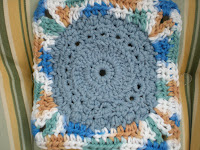Here's what you'll need:
1. Plarn and lots of it (200 grocery bags worth to be safe. If you don't have 200 grocery bags to make plarn don't go to the grocery store to get it. That will defeat the purpose of recycling. Ask your friends and family. I am sure grandma has millions stashed somewhere. For a tutorial on how to make plarn here is a link to my previous post:2. Crochet Hook Size H/5.5mm
3. Red Ribbon: 7/8" width I took about 4-5 skeins of it.
5. 4 Stitch Markers or Safety Pins or Paper clips to keep your space.
6. Safety Pins to attach skeins of ribbon
6. Needle and red thread (or whatever colored thread to match your ribbon)
Here's the Pattern:
To begin, you construst the base:
Ch 36.Row 1-13: Sc into each of the 36 ch, ch 1, and turn.
Row 14: Sc into the next 35 sc, 3 sc in the next sc at the end of the row (i.e. 36 sc st) (This makes the corner, sc in the sts that make up the width of the bag (about 12 sc), 3 in the last stitch that makes up the width (this will make the corner) Now you are on the other side of the length of the base where you originally chained 36. Sc in each of the next 35 st, 3 sc in the next sc at the end of the row (i.e. 36 ch st) (This will again make the 3rd corner), sc in the sts that make up the width of the bag (about 12 sc), 3 in the last stitch that makes the width and slip stitch to join the beginning row.
 Now on to constructing the body of the bag:
Now on to constructing the body of the bag:
Row 15: Ch 1, sc in the BL only in each sc in the round. Sl st to join rnd.Row 16: Ch 1, sc in both loops in each sc in the round. Sl st to join rnd.
Row 17,21,25,29,33,37: Ch 3 (counts 1 dc), dc in both loops in each sc in the rnd. Sl to join rnd.
Row 18,22,26,30,34,38: Ch 1, sc in both loops in each dc in the rnd. Sl St to join rnd.
Row 19,23,27,31,35: Ch 4 (counts as 1 dc and ch 1), skip sc, *dc in the next sc, ch 1, skip the next sc,** repeat * to ** 54 x, sl st to join rnd.
Row 20,24,28,32,36: ch 1, sc in each sp in the rnd. Sl st to join rnd.
Lastly, how to construct the shoulder straps for the bag:
Preparation for placement of straps: Lay the bag flat. Measure 5" in on the right and left end of the bag and mark with a stitch marker or a safety pin. Do this on the other side of the bag as well. The 5" marker is the middle of each strap. This will mean you will have 4 stitch markers in all (two on each side of the bag) Crochet the the straps to the following pattern:*Row 1: Sl st into the sc that 2.5" from the end of the bag and the stitch marker.Ch 1, sc in the next 7 sc. (You will have to take out yout stitch marker when you do this, but you will no longer to need on this end of the bag).
Row 2: 1 ch, sc in the next 3 sc, ch 1, skip next sc, sc in the next 3 sc.
Odd numbered Rows: Sc in the next sc.
Even number Rows: ch, sc in the next 3 sc, ch 1, skip next sc, sc in the next 3 sc.
You will have to repeat the even and odd numbered rows until you have 77 rows in total. Sc the strap to the other end of the bag on the same side of the bag making sure that the middle of the strap is at the place where the other st marker is. Remove the stitch marker if it is the way. I know that sounds funny but that is the only way I can describe it. I might have to illustrate with pictures at some point.** Repeat from * to ** for the other side of the bag.
Adding the Ribbon Embellishment
You'll that you created gaps in the body of the bag for rows 19,23,27,31,35. This is where your ribbon will go.Step 1: I safetypin my ribbon to the place where I start to creat some tension. Weave from outside to the inside in the gaps horizontally. If the ribbon fills up the gap on one row move your ribbon up without cutting. Trust me don't cut anything because if you mess up you will have stitch the ribbon up later. Do this until all the gaps are filled in in the body of the bag. When you run out of a skein saftey pin the end of one skein to the beginning of the new skein of ribbon.
Step 2: Once you are happy with the placement of the ribbon, cut off the remaining ribbon that did not get weaved in. Hand stitch where you put safetypins were that connected the ribbon.
Step 3: Hand stitch with a needle and thread the ribbon to inside of the bag only. You don't want the red thread to show up on the outside of the bag at the ends of the ribbon. You don't need to stitch long the route of the ribbon.
The ribbon embellishment for straps are made the same way, except you won't need to safety pin the ribbon as you will only need one skein for both straps. Sew the ribbon into the inside of the straps at the ends only
Take this beautiful bag with you to grocery for one-stop/one-bag shopping. Or go to the beach with all the towels, sunscreen. bottled water, and snacks that you cram into this huge bag!




































